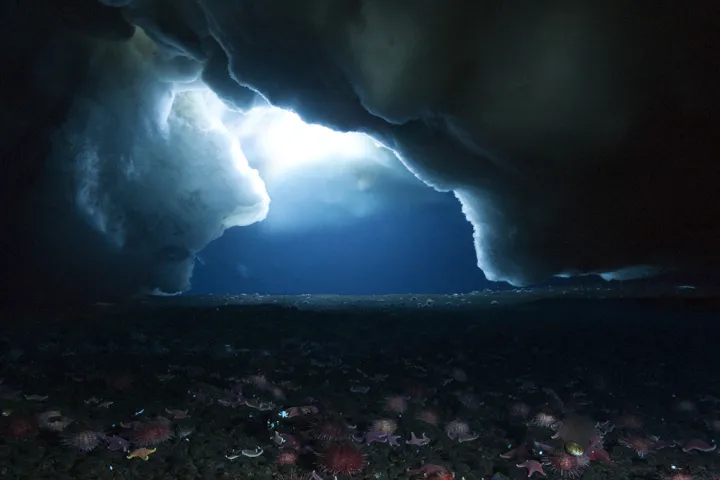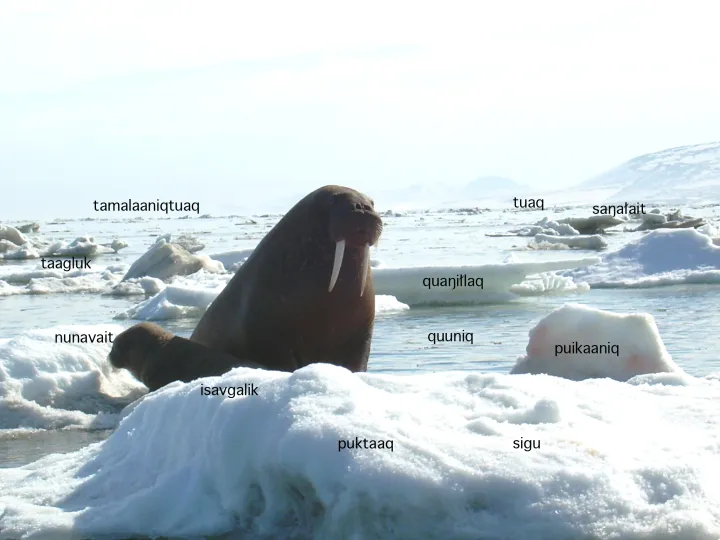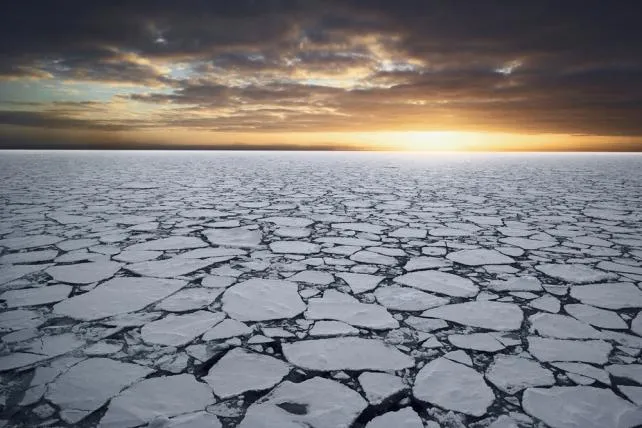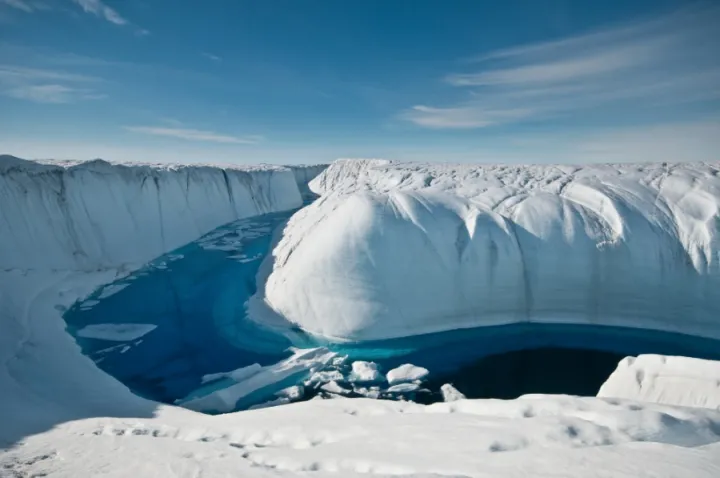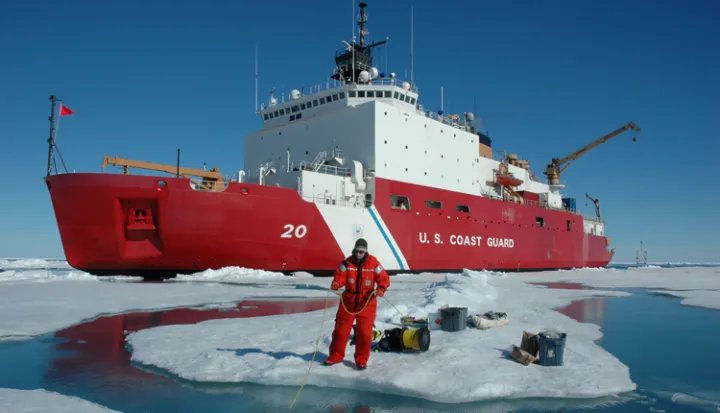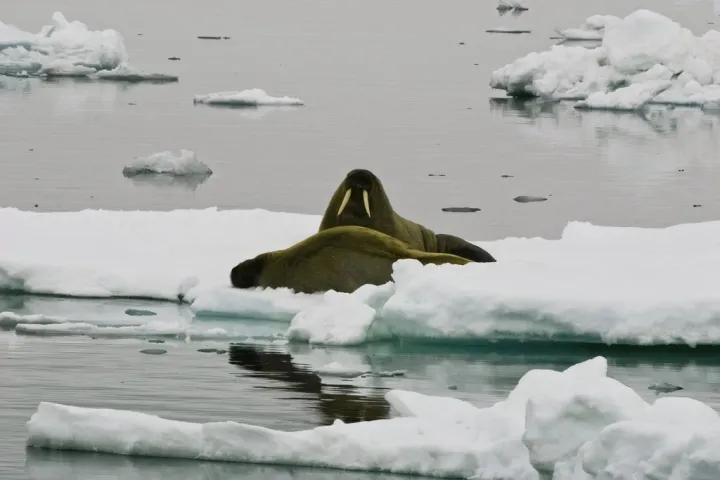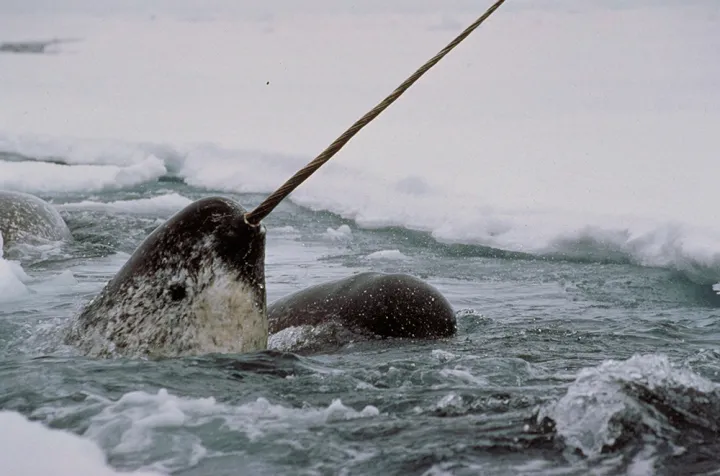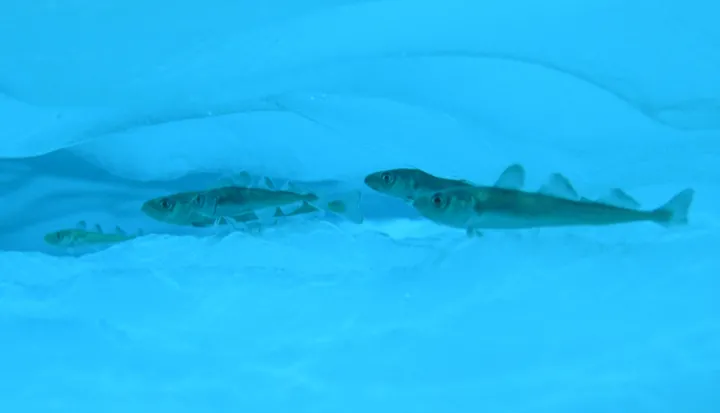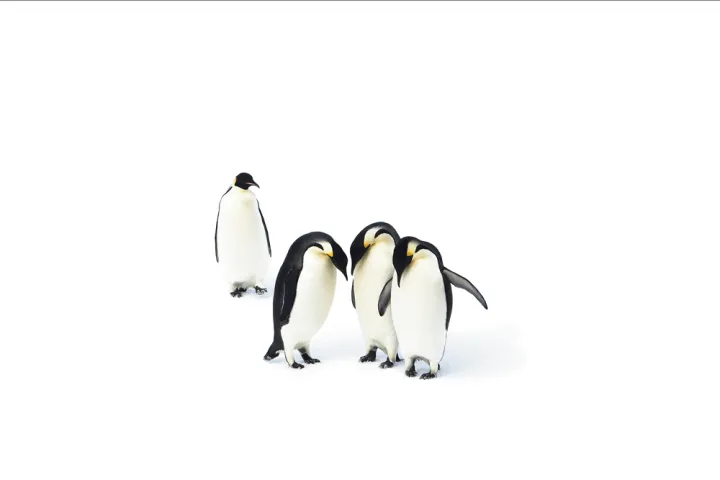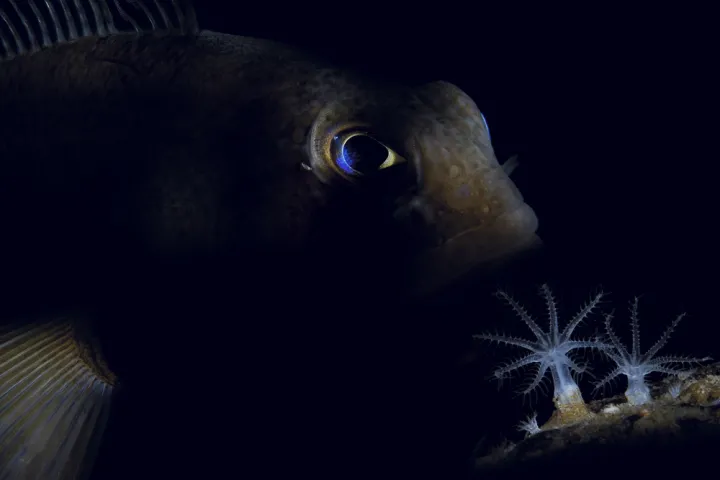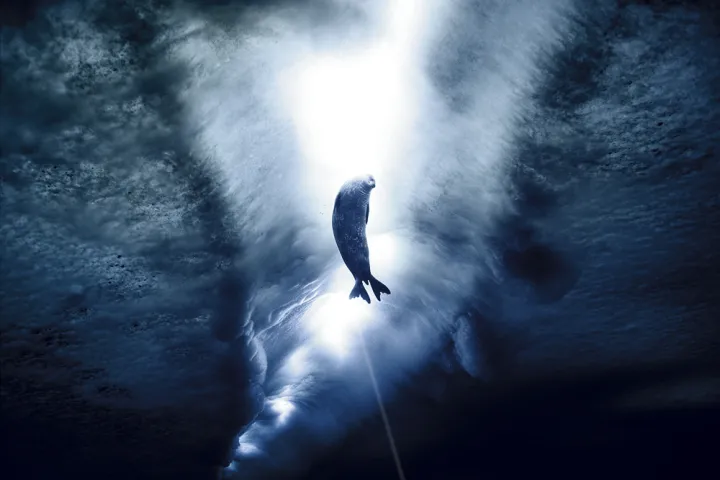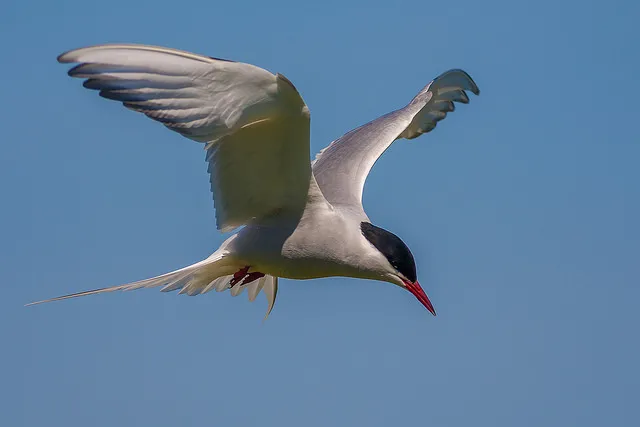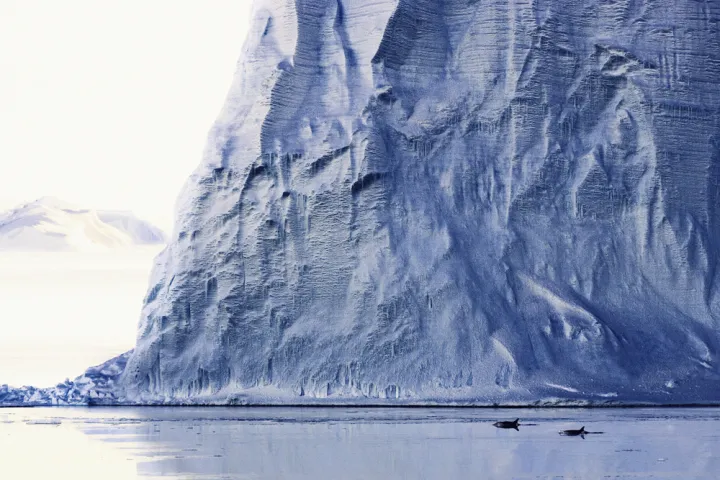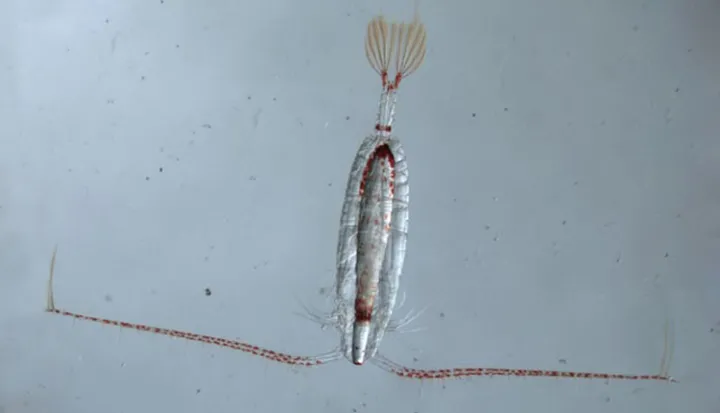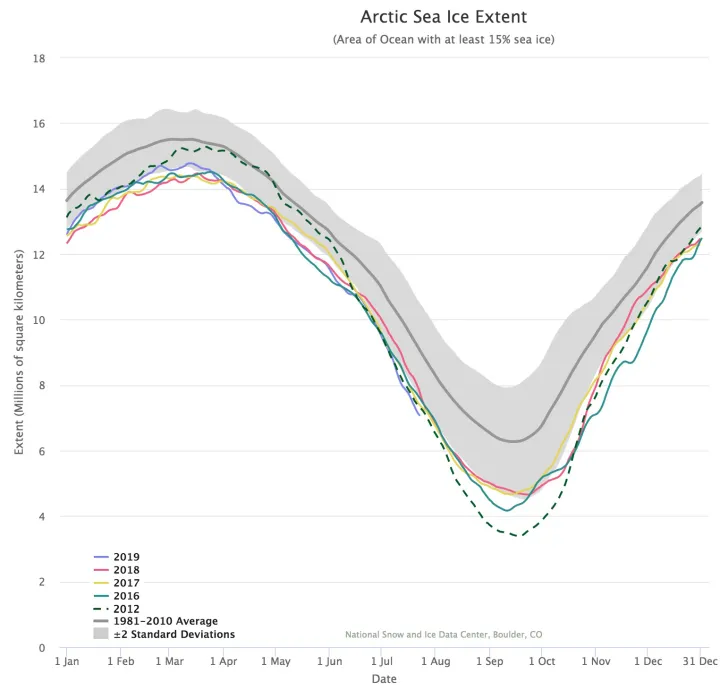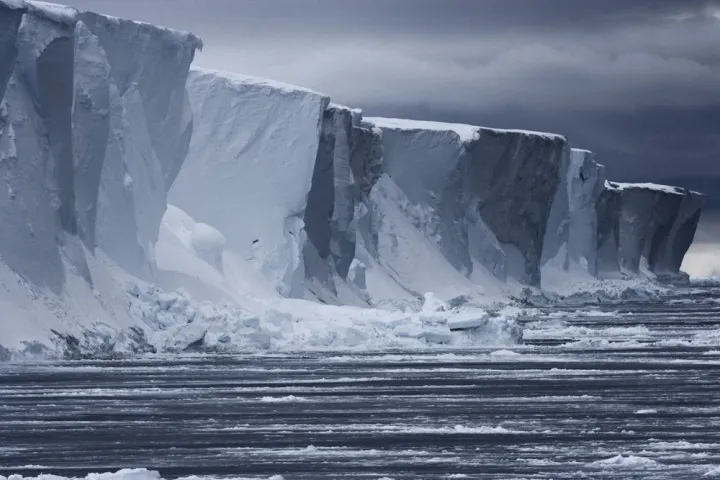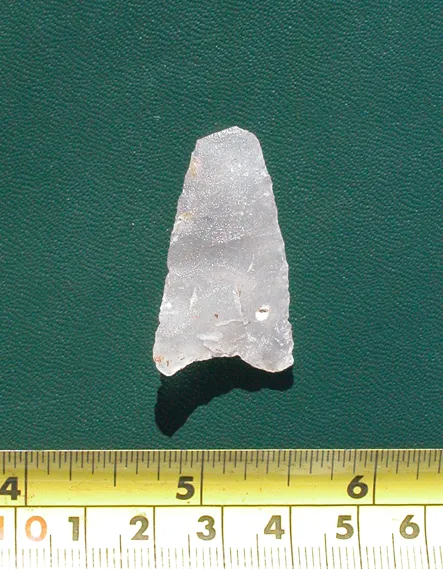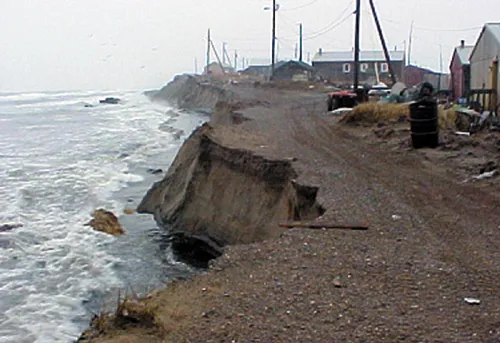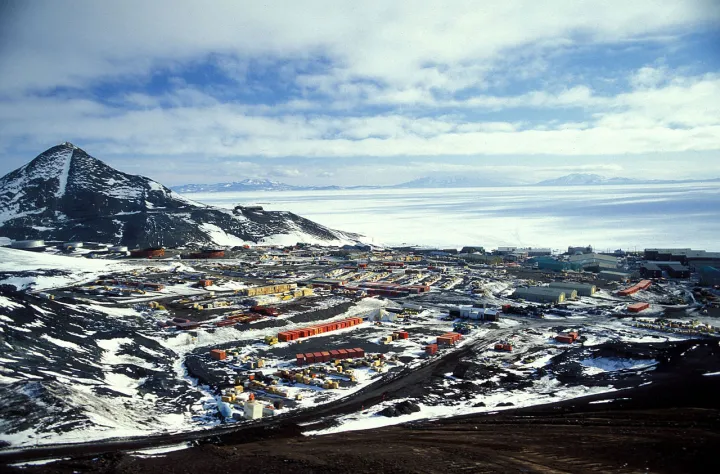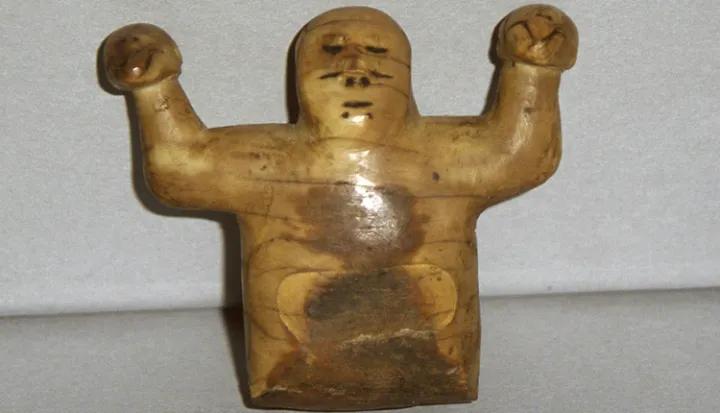
The Arctic and The Antarctic
Introduction
Travel to the ends of the earth—literally—and discover the polar ocean basins. Both the Arctic Ocean and the Southern Ocean are defined by ice and dramatic shifts between endless day and endless night. The environments at the poles are some of the harshest on Earth—yet animals have found ways to survive there against the odds.
Although both are icy and frigid, the poles are actually more different than you might expect. In the northern polar region, the water and ice of the Arctic Ocean are surrounded by land. Depending on the season, much or all of the Arctic Ocean is covered by a layer of sea ice, ranging in thickness from a few inches to over six feet, which is always shifting as it floats on the ocean's surface. On the adjacent land, communities of native peoples have thrived for thousands of years by adapting to life along the edge of the ice.
Meanwhile, the southern polar region has the opposite geography, with the huge landmass of Antarctica surrounded by the turbulent Southern Ocean. All but one or two percent of Antarctic land is covered by glaciers, some of which are more than 15,000 feet (4,700 meters) thick. In the Antarctic, the only human residents are scientists and technicians at isolated research stations whose food must be shipped in by boat.
Ecosystem Basics
Arctic Ocean
The symbol of the Arctic is often the polar bear, the pole's cute yet fearsome top predator. These large marine mammals, who move easily between ice, water and land, are part of the diverse fauna of the Arctic Ocean.
What keeps this marine ecosystem going are organisms you can't see with the naked eye: microscopic phytoplankton and ice algae. Come March, the sun rises low in the Arctic horizon, and it won't set until six months later in September. During this bright period, Arctic algae and phytoplankton kick into overdrive, using photosynthesis to use the 24-hour sunlight to make food.
This explosion of life supports the entire food web for the whole year—from soft corals on the seafloor to the arctic foxes on the ice. The blooms of algae and phytoplankton feed zooplankton and larger predators, which are themselves in turn eaten, and so on up the food chain. When uneaten organisms die, they sink to the seafloor, feeding fish, seastars, soft corals, and other organisms in deeper water.
The sun-fed plankton are also important for the indigenous peoples of the Arctic who get food and clothing both from the sea (walrus, narwhals, beluga, other whales, polar bear, and fish) and the land (caribou, reindeer and musk-ox). Without phytoplankton and algae, the large marine animals would not have food to eat.
Southern Ocean
Antarctica is the coldest, driest, and windiest of Earth's seven continents, and 98 percent of the continent is covered by ice with no tundra, trees or bushes. Even in the southern summer, the average temperature is -17.5°F (-27.5°C), although along the coast it is warmer.
Antarctica is isolated from the rest of the continents by the Circumpolar Current, which swirls clockwise around the landmass. This current pulls up cold, nutrient-rich waters from the deep sea to the surface, a process known as upwelling. The nutrients cultivate blooms of phytoplankton and ice-algae, which feed a super-abundant supply of Antarctic krill, small shrimp-like crustaceans. Large animals, like penguins, whales, and seals all feast on the krill. Under the thick ice on the seafloor, communities of worms, bivalves, bryozoans, and other invertebrates thrive, despite never seeing the light of day.
Unlike the Arctic, there are no indigenous communities based in Antarctica. The people that live here are mostly scientists and technicians engaged in research.
Polar Ice
Many different types of ice can be found in the Arctic and Antarctic. Ice can be classified by age, whether it is made from fresh or salt water, or by its ever-changing forms. From giant glaciers to thin pack ice, each has distinctive characteristics, and those who have spent time in the Poles, from native people to sailors, have hundreds of names for the different kinds of ice.
Sea-Ice
Sea ice is by definition made from frozen seawater, which gives it different properties than ice made of freshwater. Its formation begins in very cold water surrounded by thicker sea ice or land with a slushy mix of water and ice crystals on the sea surface, called frazil ice. Then a film of ice forms, called grease ice, named for its close resemblance to the look of an oil slick on water. From this thin layer, the ice becomes thicker and stronger, forming pack ice. Pack ice is also referred to as drift ice because it is not attached to a shoreline and can be moved by the wind and ocean currents. The sea-ice closer to land and attached to the shoreline is called fast ice (short for fastened).
When salt water becomes ice, some of the salt is left behind in the water, making the water directly below sea ice saltier and denser than most seawater. This dense, salty water sinks and travels towards warmer tropical waters along the seafloor, forming part of the ocean’s great circulating “conveyer belt”. In 2011 a BBC crew filmed a never-before-seen phenomenon of the salt water sinking below newly formed ice and the water around it slowly freezing. This “brinicle,” as it is called, eventually reaches the sea floor where it covers the animals living there (like sea stars and urchins) in a layer of deadly ice.
Sea ice forms during the winter, more than doubling the size of the Antarctic continent, and then melts in the spring and summer. In the Arctic, some of the sea ice stays throughout the year, called multi-year ice.
Land Ice
Glacial ice forms on land, and is made of freshwater snow packed down tightly over many years. Glaciers, icebergs and ice sheets are all formed from glacial ice. The Greenland and Antarctic ice sheets are the only ice sheets currently on Earth, and they contain 75 percent of the freshwater in the world. When ice sheets grow and move out over the ocean they form ice shelves. Icebergs are formed when chunks of glacial ice break off (called calving) from an ice sheet or shelf. They float with most of their mass below the water, hence the expression “tip of the iceberg”. It is land ice that, as it melts, contributes to sea-level rise.
Learning From Ice
To study ice, sometimes you have to break it. The U.S. Coast Guard Cutter Healy is a ship with a primary mission to serve as a research platform in the Arctic. Even in the twenty-four-hour light of summer, the multi-year sea ice can be nearly 2 meters thick and the ship's job is to cut right through the ice, no matter its thickness. Scientists also use ice cores to gain insight into the Earth’s ancient atmosphere. The ice has trapped bubbles, salts, and sediments that can help tell the story of how the climate has changed. This is especially important now that humans are emitting carbon dioxide at an unprecedented rate (see Threats to the Poles section).
Creatures of the Poles
Arctic Ocean
Polar Bears
Imagine it being 40 degrees below zero (Fahrenheit and Celsius are equal at this temperature!) and not shivering. You could do that if you were a polar bear. Polar bears have two layers of fur, plus a layer of blubber to keep them warm in the coldest weather, and black skin to absorb the heat. They have hollow guard hairs that keep fur from matting when it gets wet. In fact, polar bears are more concerned about overheating than about getting cold. Because they are such strong swimmers, polar bears earned the species name of Ursus maritimus—bears of the sea. They can swim for miles and stay submerged for two minutes at a time.
Walrus
A thick layer of blubber keeps walruses warm in the Arctic. Both male and female walruses have strong long tusks that they use to help pull themselves out of the water. They can also use their tusks to break through the ice to create breathing holes. Walruses forage on the seafloor, diving to depths up to 180 meters (590 feet) for clams, cockles, and mussels. They use highly sensitive whiskers on their snouts to locate food. Then they dig out their prey using the tough edges of their noses, similar to how pigs root around in dirt and grass.
Narwhals
Unicorns may be creatures of the imagination, but narwhals are the real deal. There are roughly 172,000 of them swimming in the Arctic today. A large portion of narwhals lives in Baffin Bay, which is the body of water between the northeastern coast of Canada and Greenland. Smaller populations live off the eastern coast of Greenland as well. In the winter narwhals live offshore among the ice floes, but in the summer, when the ice melts, they migrate towards the shore and congregate in summering grounds. They live and travel in pods that range in size from a few narwhals to several hundred individuals, but in the summertime, the congregations can be in the thousands. Females, young, and immature males live together and adult males live in their own pods.
A narwhal is a toothed whale and is closely related to dolphins, porpoises, and orcas. The famous tusk is actually a specialized tooth that protrudes out of the left lip, and in rare cases, a narwhal can have two. The longest tusks can reach over eight feet long (2.4 meters). While all males have a tusk, only 15 percent of females have a tusk, leading scientists to believe it has a role in sexual selection. Understanding the function of the tusk is an ongoing area of investigation.
Diving is one of the narwhal’s special talents. They are some of the deepest diving whales with a record dive around 5,900 feet (1,800 meters)—over a mile deep! Traveling at such depths where there is intense pressure requires a few special adaptations, including a compressible rib cage and streamlined body. They are also excellent at conserving oxygen—their muscles are built to minimize oxygen use and simultaneously can carry large amounts of oxygen. During the deepest dives, a narwhal can shut off oxygen flow to unessential organs and instead divert it to where it is needed most.
Arctic Cod
Arctic Cod can live in water that is cooler than the freezing point of blood. Like the Antarctic ice fish, they have an antifreeze protein that keeps their blood flowing. Arctic Cod are critical players in the Arctic food web. They eat small crustaceans, such as amphipods and copepods. And in turn, Arctic Cod are food for seabirds and many marine mammals.
Southern Ocean
Emperor Penguins
Emperors are the largest of all penguins—about half the height of adult humans. Among the hardiest of the polar creatures, the male emperor penguin is the only animal that remains throughout the winter on the Antarctic continent. The female penguins leave the males to protect their one egg and cope with wind chill temperatures of -60°C (-76°F). The male penguins huddle together and keep the egg warm by balancing it on their feet and covering it with their skin. They take turns moving into the center of the crowd to warm up and then trading places with a penguin on the cold perimeter.
Icefish
In oxygen-rich Antarctic waters, ice fish can withstand temperatures that would freeze the cells of other fish. They have no hemoglobin—the oxygen-carrying protein that makes red blood cells red. In the absence of hemoglobin the gills of ice fish appear white. The ice fish instead have special blood that contains proteins that act like antifreeze. The fish actually have ice crystals inside their bodies and the special proteins ensure that the crystals don’t grow in size. But researchers have also found that the ice crystals don’t go away during the warmer summer months—one of the implications of living below the ice. This protein is also found in a group of more than 120 fish that live in the Southern Ocean.
Icefish breed in large underwater colonies. The largest breeding colony discovered is a massive nesting site of Jonah’s icefish (Neopagetopsis ionah) in the Weddell Sea. An area around 92 square miles (240 square km) at a depth of 1,640 feet deep (500 meters) contains nest after nest with each containing around 1,700 eggs.
Weddell Seals
Weddell Seals live year round in the frigid waters of the Southern Ocean. They inhabit the "fast ice"—sea ice that is attached to the shore. These seals do not migrate and are commonly found within a few miles of their birthplace. When sleeping and resting, Weddell seals may remain in the same spot for hours, melting a hollow in the ice underneath them with their own body heat. Swimming under the ice they can dive as deep as 700 meters (2296 feet) and attack prey, such as small fish, from below. The fish above are backlit by the ice above and easily spotted in silhouette. Weddell seals are very vocal and have a large repertoire of sounds. Recent studies in the Ross Sea suggest the loud vocalizations may be used to stun prey.
Pole to Pole: Shared Species?
More than 11,000 kilometers (6835 miles) separate the Arctic from the Southern Ocean. So scientists thought only a few species would live in both places until researchers taking part in the Census of Marine Life found over 200 species that appeared to live in both polar seas, including cold-water worms, crustaceans, sea cucumbers and pteropod snails. But, further genetic testing proved that they were in fact, not the same species and that the miles between do make a difference. Some animals make fantastically long migrations, moving from the Arctic to the Antarctic and back again every year, living an endless polar summer.
Arctic Tern
The Arctic Tern could really be called the Arctic-Antarctic Tern. It has the longest migration of all birds, flying from breeding grounds near the North Pole to wintering grounds off Antarctica. That's a journey of about 40,000 km (25,000 miles), often made in less than four months. Makes you feel tired just thinking about it.
Orcas
Orcas, also known as killer whales, can be found in both the Arctic and the Southern Oceans. Orcas stay put in their distinctive ecosystems, and there are different characteristics of the groups (or pods) in various locations. All orcas are currently considered to be the same species, although there is some thought that they might be different species among the pods in Antarctica, or at least subspecies (pdf). They are the largest of the dolphins, and powerful predators. Orcas travel in pods of up to 40 related individuals. These pods act like wolf packs - working together to take down prey, including seals and larger whales. Orcas communicate through a wide range of sounds, and each pod has an audio signature that members can recognize from far away.
Krill and Copepods
At both poles, tiny animals, called zooplankton, are near the base of the food chain. They eat the photosynthesizing phytoplankton and in turn are food for fish, seabirds and marine mammals. In the Southern Ocean, Antarctic krill swim in dense schools of 20,000 animals per cubic yard (540,000 cubic feet). In an amazing feat of synchronized swimming, they use a staggered formation so that no krill swims directly in another's wake. That way they avoid turbulence. In the Arctic Ocean, different species of copepods have different life cycles and eating patterns and they are important sources of food for larger organisms. Scientists are just beginning to understand who eats whom in the polar oceans.
Threats to the Poles
Climate Change
Among the biggest threats to the poles is rapid climate change. Atmospheric carbon dioxide has been rising for more than a century, with large contributions from the fossil fuels used to power our homes, businesses, and cars. These increasing concentrations of greenhouse gases are trapping heat and taking a toll on the planet, especially at the poles where the largest increases in temperature will occur. Global temperatures have increased since the 1800s, and sea ice has been decreasing in extent and thickness.
While details concerning the extent of future impacts of climate change are the subject of debate, the Arctic is experiencing those changes today. It's warming at twice the rate of the rest of the planet. From 1979 to 2005, sea ice cover declined by about 20 percent. Scientists have discovered that the ratio of thick to thin sea ice is changing. In years past, thicker ice was about 40 percent of total ice cover. Now it's down to just 10 percent and the Arctic may have ice-free summers by the end of the 21st century. The amount of multi-year ice that remains from year to year has been declining since the 1980s due to warming temperatures, leaving mostly newer, thinner ice on the surface. Some areas of the Arctic Ocean, like the Barent Sea north of Scandinavia, are warming so quickly that they are being taken over by Atlantic waters. The Arctic Ocean is characterized by a layer of cold, fresh water at its surface, a product of the floating ice. Since the ice has disappeared the warmer, saltier Atlantic water is able to move northward.
Because of these massive changes, the whole Arctic Ocean ecosystem will see impacts, from microscopic algae to massive polar bears to the people who call the Arctic home. Exactly how climate change will affect the Arctic is hard to predict. Polar bears, who rely on sea ice to reach seals for their winter meals, will have less time to reach their food source as the ice declines and breaks up earlier in the season. For people who live in the Arctic, weather and hunting grounds are becoming more unpredictable. Knowledge of the environment that has served generations is being defied by a changing climate. Many northern communities have also observed coastal erosion and watched the permafrost—ground that used to be frozen all year—melting and buckling under their homes and roads.
An ice-free Arctic could mean a new trade route—a Northwest Passage connecting Europe to Asia - bypassing both the Panama and Suez canals. An ice-free Arctic also opens up possibilities for drilling for oil and gas. Russia has already staked a claim, using submarines to plant a flag on the Arctic Ocean floor. Unlike the Antarctic, which is governed in part by a multinational treaty, there is no treaty currently for the Arctic polar region.
In certain regions of the Antarctic, sea ice cover is actually growing. But, overall the land- and fresh-water based ice continues to shrink. A 2018 study found that 10.7 percent of Antarctica's coastal glaciers are in retreat. Another study published in the same year found that the rate of Antarctic ice melt has tripled in the last five years. Crabs that have stayed out of Antarctic waters for millions of years because of the cold may invade and prey on animals that have no defense against their strong claws. And it is not just temperatures that are changing due to the increases in carbon dioxide. Small shelled creatures, like pteropods, which are important food sources for fish and larger animals, are already losing their shells in the Antarctic due to ocean acidification.
Overfishing
The Ross Sea: A Case Study
The Ross Sea, a 1.9 million square mile (3.6 million square km) stretch of ocean off the coast of Antarctica, has been nicknamed “The Last Ocean.” In 2008, researchers mapped out human impacts on the ocean globally and this small area of the Southern Ocean proved to be the most pristine piece of the ocean left on Earth. Melting ice isn't the only threat confronting the polar ocean. Industrial fishing, started in 1996 by New Zealand and now practiced by a dozen nations, is homing in on Antarctic toothfish and krill in the Ross Sea. If fishing on a massive scale expands to the Ross Sea, the dynamic balance of this fragile ecosystem could fall apart.
Human Connections
Arctic
Indigenous Cultures
One of the biggest differences between the poles has to do with people that reside there. Antarctica is a continent devoid of human settlement, except for the over 50 research stations built there by 27 different countries. But the Arctic region is home to more than 4 million people, many of which are indigenous people, native to the area. The indigenous people of the region encircling the North Pole are known by many names—Inuit, Eskimo, Kalaadit. Today their lands are part of four different nations—the United States, Canada, Denmark (Greenland) and Russia. For thousands of years, the people in the Arctic have adapted to living in an ice-bound environment. Key to survival is the skill with which they hunt arctic marine animals like seals and whales.
Friend Acting Strangely
"The ocean is eating up our land," says Esther Iyatunguk. Esther lives in the Alaskan coastal village of Shishmaref. From Shishmaref to Sachs Harbour, Canada, Arctic communities are on the frontlines of climate change. Sea ice used to provide protection from powerful ocean waves but now that sea ice is melting, the shoreline is eroding rapidly. Warmer temperatures also cause sea level to rise and melt the permafrost, or frozen soil. Land is being lost, along with animals that provide food for the people living in the Arctic. The mainstay of the Shishmaref diet is the bearded seal. Without sea ice, hunting has become significantly harder. Right now, residents of Shishmaref are working with the U.S. Government to relocate the entire village at a cost of $180 million.
Antarctic
McMurdo Station
McMurdo Station is the hub of the U.S. Antarctic Program. Since 1955, scientists have been coming to McMurdo primarily in the southern 'summer' months of October to February. Amidst the penguins and the seals, researchers look at everything from ecosystems underwater to ozone holes in the atmosphere. The Southern Ocean has also become a draw for ecotourists who seek to visit places where humans are far outnumbered by penguins. Ironically, the ships that bring nature-loving tourists may also unwittingly be bringing invasive species, such as plant spores and rodents that could damage the fragile Antarctic ecosystem.
Polar Science at the Smithsonian
Arctic Studies Center
The Smithsonian's Arctic Studies Center, established in 1988, is the only U.S. government program with a special focus on northern cultural research and education. In keeping with this mandate, the Arctic Studies Center specifically studies northern peoples, exploring history, archaeology, social change and human lifestyles across the circumpolar world. The Smithsonian possesses one of the world's finest anthropological collections from arctic and sub-arctic regions. The Arctic Studies Center seeks to bring its researchers together with community scholars in the collaborative exploration of the cultural heritage represented in these impressive collections.
Smithsonian Alaska Native Collections
The Iñupiaq have lived in the northern section of Alaska for thousands of years. Subsistence hunting of bowhead whales formed the basis for Iñupiaq social and spiritual life. The Iñupiaq developed sophisticated survival skills for understanding animal migrations, weather patterns, ocean currents, and more. The collection at the Smithsonian preserves thousands of artifacts from the Iñupiaq culture, including parkas made from caribou, a mask worn by a woman dancer, and an ice-scratcher used by hunters to lure seals.



